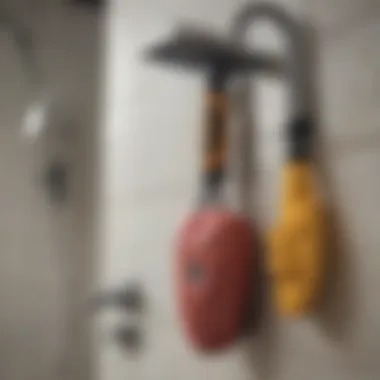How to Unblock Your Shower: Expert Tips and Techniques


Intro
In the realm of home maintenance, few issues can be as frustrating as a clogged shower. This problem can stem from various sources such as hair buildup, soap residue, or mineral deposits. Understanding how to effectively tackle this irritating situation is crucial for homeowners and renters alike. This guide aims to equip you with practical solutions to unblock your shower effectively. We will explore common blockage causes, essential tools, and step-by-step guides, along with maintenance tips to ensure your bathroom remains functional for years to come.
Key Points to Discuss
- Identify common causes of shower blockages.
- Discuss the tools needed for unclogging.
- Provide detailed, actionable steps for clearing a blockage.
- Suggest preventive measures and maintenance tips.
Through this detailed exploration, you will learn not just how to address a current blockage but also how to maintain your shower in optimal condition, avoiding future inconveniences.
Understanding Shower Blockages
Understanding shower blockages is crucial for maintaining an efficient bathroom environment. A blocked shower can lead to a range of problems: unpleasant odors, slow draining water, and in severe cases, water overflow. These issues not only cause inconvenience but can also lead to significant damage to the plumbing system, necessitating costly repairs or replacements. Thus, addressing blockages promptly and effectively is essential.
Common Causes of Shower Blockages
Shower blockages often arise from several common factors. Hair is perhaps the primary culprit. Strands can accumulate in the drain, forming clumps that trap soap residue and other debris. Soap scum is another significant contributor. The combination of grease from soaps and shampoos can create a thick layer within the pipes, further obstructing water flow.
Other common causes include:
- Mineral deposits: Hard water can lead to scale buildup within pipes over time.
- Foreign objects: Items like razors, shampoo bottles, or even toys can accidentally fall into the drain.
- Poor plumbing design: Sometimes the layout of pipes can lead to water not flowing efficiently.
Awareness of these factors can aid in both prevention and remedying issues as they arise.
Impact of Hair and Soap Residue
Hair and soap residue form an almost inescapable partnership in creating blockages. Hair collects slowly over time, intertwining with soap scum. This interaction causes a buildup that can be increasingly difficult to eliminate. The residue forms tight networks that obstruct the passage of water, leading to minor flows which can, over time, develop into severe clogs.
Regular cleaning practices can minimize the impact of these elements. Utilizing mesh covers for drains can also catch hair before it enters the plumbing. This upkeep conserves the system’s functionality and lengthens the time between necessary cleaning efforts.
Importance of Drainage System Design
The effectiveness of a drainage system largely depends on its design. Well-structured drainage can facilitate smooth water flow, reducing the likelihood of blockages. Key considerations include the angle of pipes, the size of the drainage outlet, and the installation of proper venting.
Inadequate drainage can lead to water pooling, which exacerbates blockage issues. For homeowners looking to improve their systems, consulting with plumbing experts about the design and layout of existing drainage can yield beneficial insights.
"An efficient drainage system is the backbone of a well-functioning bathroom."
In summary, understanding shower blockages is foundational for effective maintenance. Awareness of common causes, the effects of hair and soap residue, and the significance of proper drainage design can pave the way for both immediate solutions and long-term prevention strategies.
Identifying the Type of Clog
Identifying the type of clog is essential in addressing shower blockages effectively. Every blockage presents unique challenges and potential solutions. Recognizing the specific nature of the clog can save time and effort, allowing homeowners to implement the most suitable unblocking methods.
Assessing Water Flow


Assessing the water flow is the first step in identifying the type of clog. Observe how water drains from the shower after use. If water pools around the feet during a shower, it indicates an issue. Slow drainage generally signals a partial blockage. It is crucial to note if this occurs at random times or consistently, as it speaks to the severity and location of the clog.
Determining the Location of the Clog
Determining the location of the clog involves checking different areas in and around the shower. Start by inspecting the drain itself and the visible piping under the sink or toilet that may connect to the same drainage system. Clogs can form in various places, but it is important to focus on high-traffic areas like the trap or bends in the pipes. A flashlight may help see inside the drain, making detection easier.
Signs of Severe Blockages
Recognizing signs of severe blockages is key to preventing further damage. If water backs up into the bathroom floor or nearby fixtures when using the shower, this often implies a major clog further down the line. Other signs include unpleasant odors arising from the drain, bubbling noises, or even standing water not receding. Such symptoms warrant immediate attention, as they may indicate that the blockage could lead to more serious plumbing problems.
"Addressing the problem early can save significant costs associated with extensive plumbing repairs."
By understanding how to identify the type of clog, homeowners can tailor their responses to effectively clear blockages and restore normal shower function.
Tools Required for Unblocking
Unblocking a shower requires a range of tools that cater to various types of clogs. Understanding these tools is fundamental for effectively addressing a blockage, ensuring that homeowners can manage issues without extensive professional intervention. The right tools not only facilitate the unblocking process but can also save time and reduce frustration.
Essential Plumbing Tools
There are several plumbing tools that every homeowner should consider having on hand. These tools differ in function, but each serves a specific purpose when it comes to clearing blockages.
- Plunger: A plunger is often the first line of defense against clogged drains. Its simple mechanism creates suction, which can dislodge minor clogs. When using one, ensure that it forms a tight seal around the drain for maximum effectiveness.
- Drain Snake: This tool is ideal for more stubborn blockages. A drain snake, or auger, can reach deeper into the plumbing to break up clogs that a plunger cannot dislodge. Users should carefully insert it into the drain and rotate it to grab or break the obstruction.
- Pipe Wrench: Though less common for unblocking, a pipe wrench can be useful in making adjustments. If a part of the plumbing needs to be removed for access, this tool provides the grip needed to turn stubborn fittings.
The effectiveness of these tools is contingent upon their proper use and maintenance. Familiarity with each tool's function is critical for successful unclogging.
Chemical Drain Cleaners: Pros and Cons
Chemical drain cleaners can offer quick solutions to shower blockages. These products contain harsh substances designed to dissolve hair, soap scum, and grease. However, they require careful consideration before use.
- Pros:
- Cons:
- Speed: Chemical cleaners often work quickly, allowing for immediate results in many cases.
- Convenience: They are easy to apply and do not require additional tools.
- Health Risks: These substances can be harmful if inhaled or if they come into contact with skin. Proper ventilation and protective equipment are advisable.
- Pipe Damage: Overuse or incorrect application can damage pipes, especially older systems. Homeowners should read instructions carefully.
In summary, while chemical drain cleaners can resolve clogs swiftly, they do pose risks that necessitate caution.
Natural Alternatives: Safe Solutions
For those seeking eco-friendly options, several natural alternatives serve as effective remedies for shower clogs. These methods generally use common household items that are safer for both users and plumbing systems.
- Baking Soda and Vinegar: This combination is well-known for its ability to dislodge minor clogs. Pouring baking soda followed by vinegar into the drain can create a fizzy reaction that helps break up build-up.
- Boiling Water: Often overlooked, pouring boiling water down the drain can dissolve soap scum and grease. It’s a simple yet effective preventative measure that can keep drains clear.
Natural solutions present a gentler approach to plumbing maintenance. They can be repeatedly used without threatening pipe integrity.


Both chemical and natural solutions can play a role in drain cleaning, but balance and caution are important.
Step-by-Step Unblocking Procedures
Addressing clogs in your shower involves essential procedural steps that ensure effective blockage removal. Each step must be approached with care, as improperly executed techniques can exacerbate the situation or lead to damage in plumbing fixtures. This segment encapsulates various methods, detailing their effectiveness and specific considerations to take into account.
Using a Plunger Effectively
A plunger can be a simple yet powerful tool for addressing a shower blockage. To use a plunger effectively, ensure that the shower is filled with enough water to cover the cup of the plunger. This helps create a stronger seal. Position the plunger over the drain and push down gently to remove air. Then, apply firm and rapid strokes, pulling and pushing the plunger. It is important to keep an eye on the water level. If it begins to drain, you probably succeeded. Repeat the process if necessary. Overall, using a plunger is straightforward and generally safe for plumbing.
Employing a Drain Snake
The drain snake, or auger, is particularly useful for more persistent clogs that resist other methods. Insert the snake into the drain with a steady hand. As the device moves through the pipes, it will catch clogs and debris. Unlike plunging, this method can effectively reach deeper blockages without needing substantial force. Make sure to rotate the handle and gently pull back when you feel resistance. If you successfully retrieve any debris, dispose of it properly. Be cautious when using the drain snake to avoid damaging pipes.
Utilizing Chemical Cleaners
Chemical cleaners provide a quick solution for blockages, especially grease-related issues. These solutions typically work by dissolving organic matter and breaking down soap scum. However, exercise caution with these products as they can contain harmful ingredients. Read instructions carefully and ensure proper ventilation during application. Follow safety precautions using gloves and goggles. While the immediate effect can be beneficial, relying too much on chemical cleaners can damage your plumbing over time.
Applying Natural Remedies
For those preferring eco-friendly measures, natural remedies can be effective. A combination of baking soda and vinegar is often recommended. First, add half a cup of baking soda into the drain, followed by half a cup of vinegar. The reaction produces fizzing that can help displace blockages. Allow it to sit for at least 30 minutes before flushing with hot water. This approach is safer for the environment, but may not work on severe blockages. Regular use of this method can also help maintain clear drains.
It’s critical to consider both the severity of the clog and the methods chosen for remediation. Understanding the pros and cons of each technique will aid you in making informed decisions in this process.
Preventive Measures to Avoid Future Blockages
Preventive measures are essential to maintain the proper function of your shower. By implementing simple strategies, you can significantly reduce the chances of blockages over time. Taking proactive steps enhances the longevity of your plumbing system and decreases the need for urgent repairs, ultimately saving costs and time.
Regular Cleaning of Shower Drains
Regular cleaning of shower drains is vital. It helps in removing hair, soap scum, and other debris that accumulate over time. A quick clean once a week prevents buildup that can lead to serious clogs. To clean your drain, follow these steps:
- Remove the drain cover: Use a screwdriver if it is screwed in. Otherwise, it may just lift off.
- Clear visible debris: Use your fingers or a pair of tweezers to pull out hair and sludge.
- Flush the drain: Pour hot water down the drain to help dissolve soap residue.
- Use a brush: A small brush can reach areas that are hard to access. This can improve drainage efficiency.
A clean drain not only functions better, but it is also more hygienic. Keep a visible reminder in your bathroom to encourage regular cleaning.
Utilization of Drain Covers
The use of drain covers serves as a simple yet effective preventive measure. Drain covers allow water to flow freely while catching hair and larger debris before they enter the pipes. Consider the following benefits of using drain covers:
- Prevents hair and debris from entering the drain.
- Easier to clean: Simply remove and wash the cover rather than clearing an entire blockage.
- Various styles available: Choose one that fits your bathroom aesthetic and functionality.
Ensure the cover fits well and is checked regularly for any accumulation under it. Proper installation adds an extra layer of protection against clogs.
Establishing a Maintenance Schedule


Creating a maintenance schedule is another effective strategy to prevent future blockages. Just like any other part of your home, your shower requires routine attention. An organized approach to maintenance can help keep your plumbing system in good shape.
- Monthly Checkup: Inspect what’s going down the drain. Avoid using the shower as a bathroom sink.
- Biannual Deep Clean: Consider a professional inspection to check for any plumbing issues that you might not notice.
- Seasonal Reminders: Use seasonal changes as a cue to check on your drains, making it more manageable to remember.
By committing to a maintenance schedule, you ensure that potential issues are identified and addressed early. This simple effort can curb long-term damage.
“An ounce of prevention is worth a pound of cure.”
When to Call a Professional Plumber
Knowing when to call a professional plumber is essential for homeowners who may face unexpected plumbing issues. While some blockages can be managed personally, others can signify deeper problems in the plumbing system. Recognizing these situations can save time, effort, and potentially significant costs associated with further damage.
Recognizing Severe Blockages
Severe blockages often manifest through certain clear signs. If water drains slowly or not at all in the shower, it indicates more than just a minor issue. Often, these severe blockages can be caused by a significant accumulate of hair, soap residue, or other foreign objects that resist basic cleaning methods.
Additionally, foul odors emanating from the drain can signal stagnant water or decomposing material within the pipes, which may not be easily accessible. Other indicators include recurring backup issues, gurgling noises from drains, or water pooling in other areas, such as sinks or toilets in the same pipeline system.
Each of these factors suggests a more complex problem that might be beyond a simple fix with a plunger or snake. Therefore, if you experience one or more of these symptoms, it is prudent to contact a professional for evaluation and resolution.
Understanding Plumbing System Complexity
A shower's drain operates as part of a larger plumbing system that includes pipes, vents, and connections to municipal or septic systems. Understanding this complexity is crucial when considering whether to reach out to a plumber. If a blockage affects multiple drains, it may point to a broader issue such as tree roots invading sewer lines or deterioration of the piping materials.
Professional plumbers have the tools and expertise to diagnose intricate plumbing systems effectively. They can utilize advanced technology, including cameras, to inspect pipes and identify issues that are not visible to the naked eye. This is particularly important for preventing future problems that could arise from unnoticed damage.
Thus, if you suspect that your shower blockage is linked to a more significant plumbing concern, do not hesitate to seek professional assistance. It may save you from costly repairs down the line.
Closure and Summary of Key Takeaways
Effective unblocking of showers is essential for maintaining a fully functional bathroom. Throughout this article, we have examined the various methods and tools available to tackle plumbing issues caused by blockages. Understanding the common causes, identifying the type of clog, and knowing when to seek professional help are critical steps in resolving such issues efficiently.
Reiterating Effective Unblocking Methods
Successful unblocking hinges on the application of proper techniques. The following methods are effective:
- Using a Plunger: This tool can often provide immediate relief for minor clogs.
- Employing a Drain Snake: This tool reaches deep into the pipes to remove stuck debris, presenting a physical solution to more stubborn clogs.
- Chemical Cleaners: While they can be effective, caution is necessary due to potential damage to pipes and health hazards.
- Natural Remedies: Solutions such as vinegar and baking soda represent safer alternatives that can effectively clear minor blockages without harsh chemicals.
Familiarizing oneself with these methodologies ensures that you can tackle minor and moderate shower blockages, reinforcing your understanding of plumbing care.
Emphasizing Preventive Care
Prevention is always better than cure, particularly in plumbing. To reduce the chances of future issues, consider the following preventive measures:
- Regular Cleaning of Shower Drains: Keeping the drain free from hair and soap residue can prevent build-up.
- Utilization of Drain Covers: Installing a strainer can catch debris before it enters the drain.
- Establishing a Maintenance Schedule: Timely inspections can help identify potential problems before they escalate.
By incorporating these practices into your cleaning routine, you not only maintain a hygienic environment but also extend the lifespan of your plumbing system. This proactive approach yields significant long-term benefits, reducing emergency repair costs.
"An informed homeowner is an empowered homeowner. Understanding the basics of plumbing maintenance can save time and resources in the long run."
In summary, navigating the realm of shower blockages does not have to be daunting. With the right tools and knowledge, one can effectively manage their plumbing needs. The insights shared in this article serve as a foundation for homeowners to build an efficient maintenance culture, ultimately leading to a more comfortable living space.







